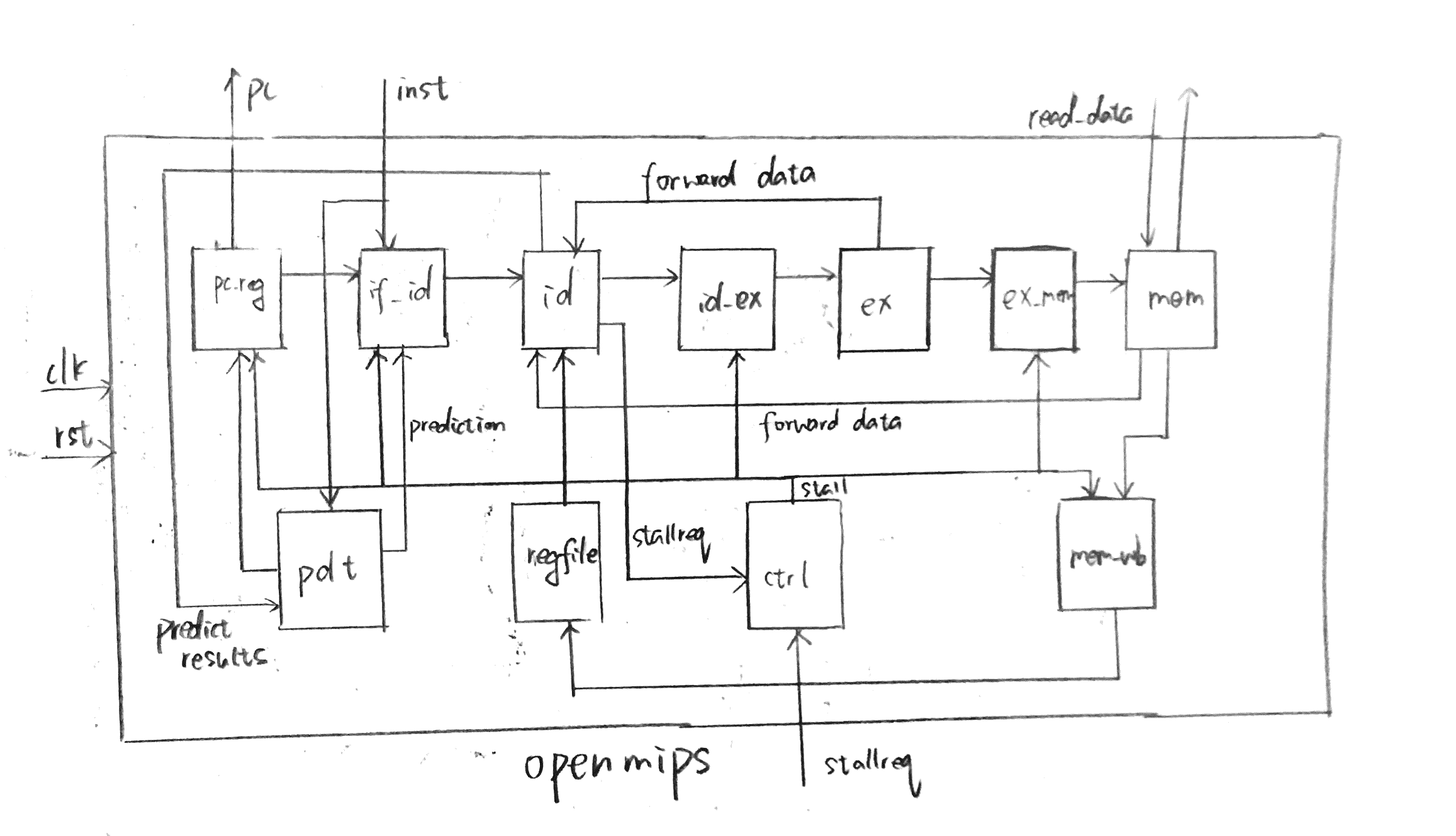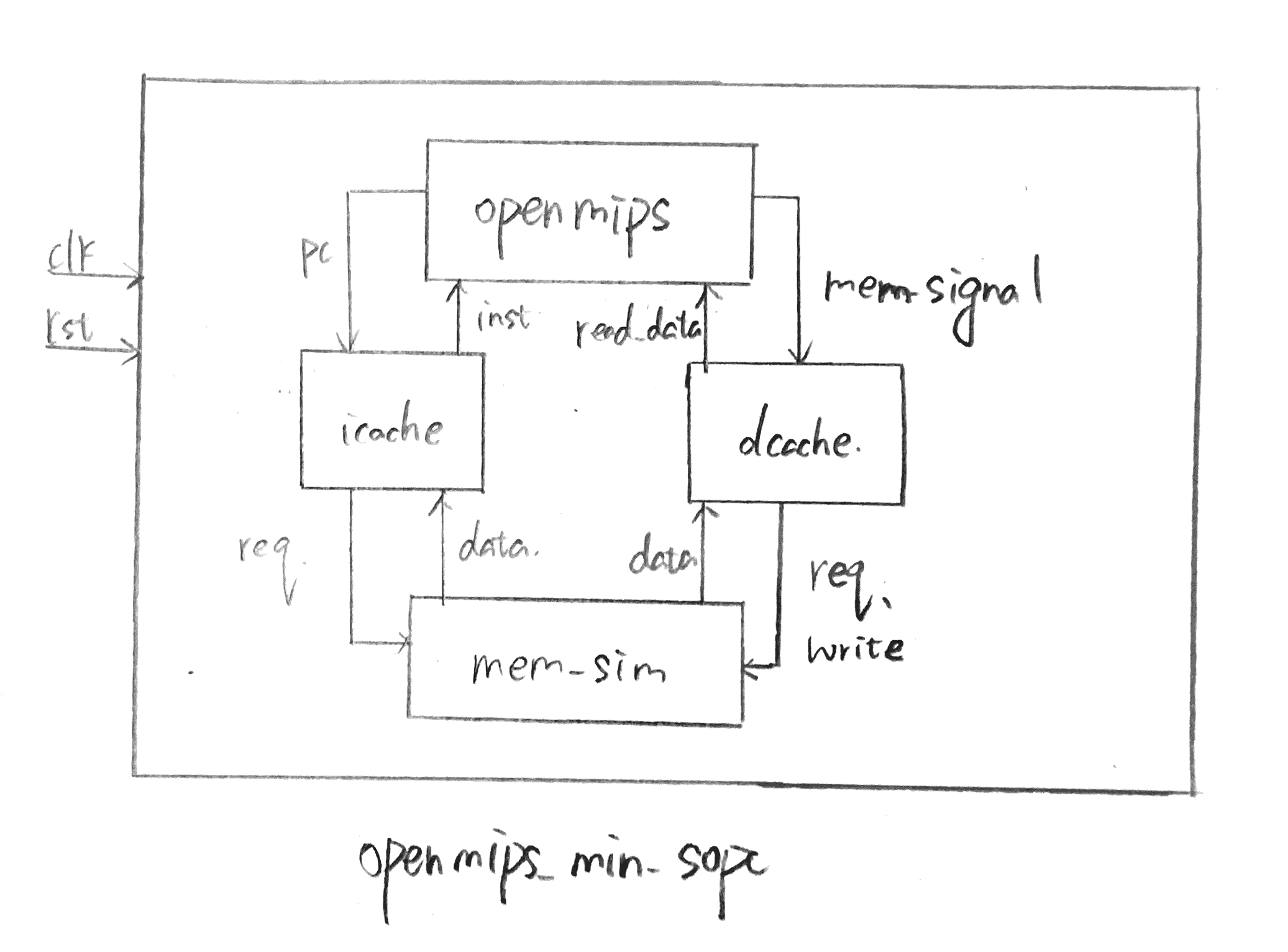This is the second homework of Computer Architecture, and the author is Lmxyy.
- Implement a Risc-v CPU using hardware description language(HDL), and then download the CPU on FPGA.
- Using C++ to simulate the memory via the USB-UART protocol.
- [X] LUI
- [X] AUIPC
- [X] JAL
- [X] JALR
- [X] BEQ
- [X] BNE
- [X] BLT
- [X] BGE
- [X] BLTU
- [X] BGEU
- [X] ADDI
- [X] SLTI
- [X] SLTIU
- [X] XORI
- [X] ORI
- [X] ANDI
- [X] SLLI
- [X] SRLI
- [X] SRAI
- [X] ADD
- [X] SUB
- [X] SLL
- [X] SLT
- [X] SLTU
- [X] XOR
- [X] SRL
- [X] SRA
- [X] OR
- [X] AND
- [X] LB
- [X] LH
- [X] LW
- [X] LBU
- [X] LHU
- [X] SB
- [X] SH
- [X] SW
- [-] UART-USB Protocol
- [X] buf_que module
- [X] uart_com module
- [ ] encoder module
- [ ] decoder module
- [X] FPGA Communication
- [X] adapter.cpp
- [X] adapter.hpp
- [X] env_iface.hpp
- [X] environment.hpp
- [X] main.cpp
According to the book 《自己动手写CPU》, implemented a riscv32 cpu which adopted Von Neumann Architecture. More details are following:
- The instruction set arthitecture(ISA) is RV32I Base Integer Instruction Set, Version 2.0.
- The implementation technology is FPGA.
- The HDL is Verilog HDL.
- The communication protocol is UART-USB.
pdt module is a branch predictor, which use tournament to predict the result:
- According to the 2nd to 11th bits in pc address, choose an alloyed branch predictor, and the then by its saturating counter decide which predictor I would use.
- If I decide the global one, I would choose a saturating counter according to the latest 10 branch results.
- If I decide the local one, I would choose a saturating counter by both the 2nd to 11th bits in pc address and the latest 3 branch results(
I guessed this would be more accurate).
Prediction will be done in the if stage, and I will pass the predicting results to pc and id. After id knows the branch results, it would deliver the feedback the the predictor.
- 2 way set-associative cache, 8 bytes in each block, and the length of index is adjustable;
- Replace strategy: LRU;
- Write strategy: write through;
- If replacement is needed, the cache will stop the cpu till the replacement finishes and the requiring data are read out from the memory(icache only stalls if, while dcache stalls all stages except wb);
- Because the memory is just a simulator, so I connect both icache and dcache to memories which make them able to read data simultaneously.
- 《自己动手写CPU》
- project-v1.0.pdf
- Branch Prediction Wikipedia
- 助教的MIPS CPU实现
- cpu-judge
- Basys3-FPGA-开发板实验参考资料
| Instruction | Format |
|---|---|
| LUI | lui rd, imm(20bits) |
| ADDI | addi rd, rs, (signed)imm(11bits) |
| SLTI | slti rd, rs, (signed)imm(11bits) |
| SLTIU | sltiu rd, rs, (signed)imm(11bits) |
| XORI | xori rd, rs, (signed)imm(11bits) |
| ORI | ori rd, rs, (signed)imm(11bits) |
| ANDI | andi rd, rs, (signed)imm(11bits) |
| SLLI | slli rd, rs, (signed)imm(5bits) |
| SRAI | srai rd, rs, (signed)imm(5bits) |
| ADD | add rd, rs1, rs2 |
| SUB | sub rd, rs1, rs2 |
| SLL | sll rd, rs1, rs2 |
| SLT | slt rd, rs1, rs2 |
| SLTU | sltu rd, rs1, rs2 |
| XOR | xor rd, rs1, rs2 |
| SRL | srl rd, rs1, rs2 |
| SRA | sra rd, rs1, rs2 |
| OR | or rd, rs1, rs2 |
| AND | and rd, rs1, rs2 |
| JAL | jal rd, label |
| JALR | jalr rd, (signed)12-bit-offset(rs) |
| BEQ | beq rs, rt, lable |
| BNE | bne rs, rt, lable |
| BLT | blt rs, rt, lable |
| BGE | bge rs, rt, lable |
| BLTU | bltu rs, rt, lable |
| BGEU | bgeu rs, rt, lable |
| LB | lb rd, (signed)12-bit-offset(rs) |
| LBU | lbu rd, (signed)12-bit-offset(rs) |
| LH | lh rd, (signed)12-bit-offset(rs) |
| LHU | lhu rd, (signed)12-bit-offset(rs) |
| LW | lw rd, (signed)12-bit-offset(rs) |
| SB | sb rs, (signed)12-bit-offset(rs) |
| SH | sh rs, (signed)12-bit-offset(rs) |
| SW | sw rs, (signed)12-bit-offset(rs) |
Run the following codes:
$ git clone --recursive https://github.com/riscv/riscv-gnu-toolchainor alternatively:
$ git clone https://github.com/riscv/riscv-gnu-toolchain
$ cd riscv-gnu-toolchain
$ git submodule update --init --recursiveThe source codes are somewhat large, please wait patiently.
Download the package at https://jbox.sjtu.edu.cn/link/view/8971e3226df74d35b2dcbe588397958f(Provided by Zhanghao Wu). Remember to depackage with the command:
tar -zxvf riscv-gnu-toolchain.tar.gzIf you use git directly, maybe you couldn’t clone all source codes which may cause that your toolchain cannot work normally.
Run the following command to get riscv32.
sudo ./configure --prefix=/opt/riscv --with-arch=rv32gc --with-abi=ilp32d
sudo makeFirst run the command
sudo gedit /etc/profileThen add
export PATH="$PATH:/opt/riscv/bin"Next, reboot or logout.
Use the following command
if [ $# -eq 0 ]; then
riscv32-unknown-elf-as -o instr.o -march=rv32i instr.s
riscv32-unknown-elf-ld instr.o -o instr.om
riscv32-unknown-elf-objcopy -O binary instr.om instr.bin
../Tools/Bin_to_Text instr.bin > instr.data
cat instr.data
rm instr.o instr.om instr.bin
elif [ $# -eq 1 ]; then
riscv32-unknown-elf-as -o $1.o -march=rv32i $1.s
riscv32-unknown-elf-ld $1.o -o $1.om
riscv32-unknown-elf-objcopy -O binary $1.om $1.bin
../Tools/Bin_to_Text $1.bin > instr.data
cat instr.data
rm $1.o $1.om $1.bin
else
echo "Please input less than 2 paraments!"
fiwhich was included in get_instr.sh. You need run the bash with exactly one parament which shows that your assembler source code’s name is “$1.s”. And you will get an file named instr.data which contains your hexadecimal riscv32 instructions. Attention: Please modify the path of Bin_to_Text according to your current directory.
The source code was Bin_to_Text.cpp.
#include<cstring>
#include<iomanip>
#include<cstdio>
#include<cstdlib>
#include<algorithm>
#include<iostream>
#include<fstream>
using namespace std;
typedef long long ll;
const int NSIZE = 8;
inline ll convert(ll num)
{
ll a[4] = {0,0,0,0},ret = 0;
for (int i = 0;i < 4;++i,num >>= 8)
a[i] = num&((1<<8)-1);
for (int i = 0;i < 4;++i)
ret = (ret<<8)|a[i];
return ret;
}
int main(int argc,char *argv[])
{
if (argc == 1||argc > 2)
{
cerr << "Please input an binary file." << endl;
return 0;
}
ifstream ifile(argv[1],ios::in|ios::binary);
if (!ifile)
{
cerr << "Cannot open file." << endl;
return 0;
}
int head = ifile.tellg(),tail = (ifile.seekg(0,ios::end)).tellg();
ifile.seekg(0,ios::beg);
int N = (tail-head)/4;
while (N--)
{
ll num = 0; int now = 0;
for (int k = 0;k < 4;++k)
{
char c; ifile.read((char *)&c,sizeof(char));
for (int i = 0;i < NSIZE;++i,c >>= 1)
num |= ((ll)(c&1))<<(now++);
}
cout.width(8); cout.fill('0');
cerr.width(8); cerr.fill('0');
cout << hex << convert(num) << endl;
cerr << hex << num << endl;
}
cerr << "Congratulations, convert successfully!." << endl;
return 0;
}- Serial Communication Library
- Boost or you could run the following command in Ubuntu
sudo apt install libboost-program-options-dev - To compile the cpp, you need to run the following command in the correspondent directory:
g++ *.cpp -c -std=c++14 -I /tmp/usr/local/include/ g++ *.o -o cpu-judge -L /tmp/usr/local/lib/ -lboost_program_options -lserial

